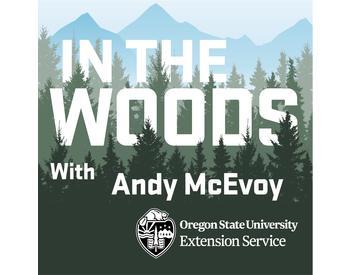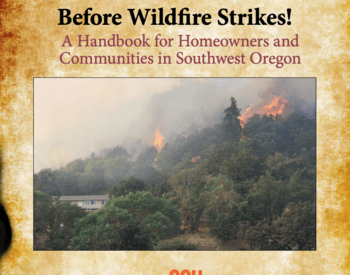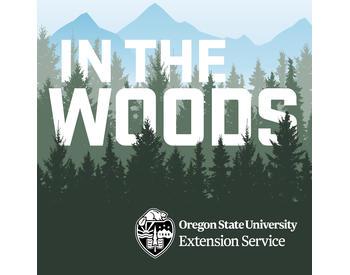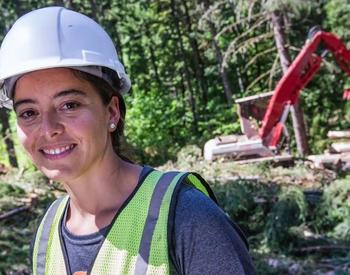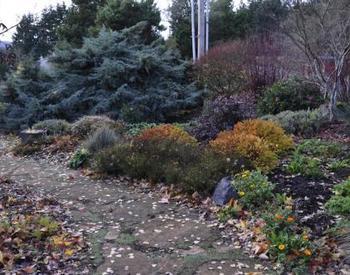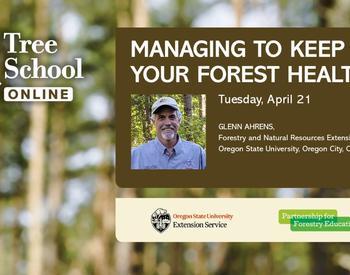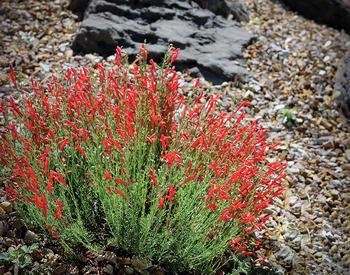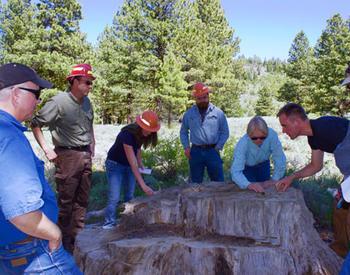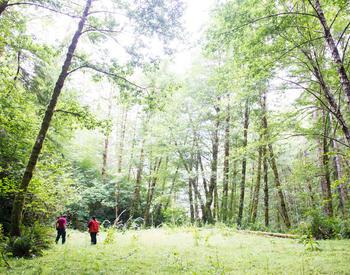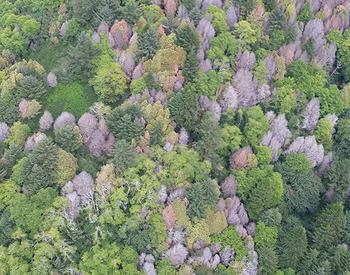Transcript
From the Oregon State University's Extension
Service, you are listening to In The Woods
with the Forestry & Natural Resources Program.
This podcast aims to show the voices of researchers,
land managers, and members of the public interested
in telling the story of how woodlands provide
more than just trees, they provide interconnectedness
that is essential to your daily life. Stick
around to discover a new topic related to
forests on each episode.
Carrie: Hello everyone and welcome back to
In The Woods podcast presented by the Forestry
& Natural Resource Extension Program at Oregon
State University. I'm your host Carrie Berger,
and while I'm not new to Extension, I am Extension's
new Fire Program Manager. This month's episode
is going to cover fire. We'll talk about the
very basics of fire, how it's used, and its
benefits, and with me today I have David G.
Lewis and Amanda Rau. David is an instructor
at OSU in anthropology and ethnic studies
and a member of the Confederated Tribes of
the Grand Ronde, and Amanda is the new Regional
Fire Specialist for the Forestry & Natural
Resources Extension Fire Program. Amanda serves
counties in the Willamette valley and north
Cascades. Welcome David and Amanda, would
you like to give a brief introduction of yourself
and the work that you do?
David: Yes, Carrie. I'm an instructor in anthropology
and ethnic studies. I've been teaching for
about three years, three and a half years
at OSU, but I've taught at most colleges throughout
western Oregon and I'm a member of the Confederated
Tribes of Grand Ronde, a descendant of the
Santiam Takelman Chinook Peoples. I've been
studying native peoples for about 25 years
and I generally will sort of research the
sort of colonial history of the tribes and
write up essays I put on my blog site, which
I call the Cortex Journal, which is at Indian
history research. These essays become part
of my curriculum for my classes, so I really
enjoy this work because I'm revealing the
history of our past which has not been well
written.
Carrie: Wonderful, Amanda.
Amanda: Thanks Carrie. I had the fortune of
starting my fire career right around the same
time that I was finishing up my philosophy
degree at the University of Oregon, and I
say that's fortunate because even though it
doesn't seem like a natural fit, my philosophy
degree and studies in that discipline were
actually what originally attracted me to fire.
But as I started working with the element
and becoming a student of fire I realized
that I needed to understand it from a different
perspective so i returned to school to do
my post-BAC at Oregon State in natural resources
and then completed a Master's in natural resources
with the fire ecology and management emphasis
at the University of Idaho. Throughout that
time I worked actively in both fire suppression
and prescribed fire management, but I've ultimately
focused my work on prescribed fire. I worked
with the U.S. Forest Service for the majority
of my career but I made a transition to work
for The Nature Conservancy about six years
ago and managed their fire program in Oregon
and Washington focusing a lot on prescribed
fire implementation and then recently I accepted
this position that I am currently in, where
I have the opportunity to share the work that
I've done with others and help educate folks
about the value of prescribed fire and the
work that fire does on the landscape overall.
Carrie: Great! So Amanda, can you tell us,
what is fire?
Amanda: Fire is by definition combustion or
burning. It's a process by which substances
combined chemically with oxygen from the air
to give out bright light, heat, and smoke.
But in the woods, fire is a natural and necessary
disturbance process that creates habitat for
wildlife, rejuvenates vegetation, cultivates
and maintains cultural resources and plays
an important role in both forest and rangeland
health.
Carrie: So actually let's dive a little bit
deeper into that, and David can you start
off and tell us how is fire used?
David: Yeah the Tribes used fire for thousands
of years. I think archaeologically there's
a record of 8,000 years in the Willamette
valley. But fire has been, was used, as a
tool by the Tribes really for various purposes.
One of which is to sort of keep down the overgrowth
in the valley that you know we know that with
a great soil, great sunlight, great conditions,
that we get way too much plant growth and
so if we let it go it becomes a huge bramble.
So fire is a very efficient way to sort of
knock all that stuff down every year. The
Tribes would set up the fire normally in the
fall, in like late September, early October
when the rains first started to fall and that
was a safe time period where you wouldn't
get a catastrophic burn you would just get
what they call a cool burn, which would burn
across the landscape and then clean up all
of the last year's debris - woody debris.
So that would serve various purposes for Tribes,
it would clear sight lines they could see
across the valley, they could see their game
you know if they needed to be hunting, they
could walk across the valley because you know
too much bramble makes it impossible to walk,
they could use fire some stories say they
use fire to perhaps herd deer and elk into
hunters, so that's one purpose. Then there's
secondary effects as well, scholars have thought
that perhaps the fire kept down on the pests
- insects and other pests - that could you
know over overtake a landscape and make it
almost inhabitable sometimes. Also it discourages
plants that the Tribes didn't want in the
valley that were not necessarily, necessary
for food in the valley of the Tribe. So such
as you know the plants, trees that we normally
associate with the forest up in the Cascades,
they don't they would not survive they don't
normally survive very well on the valley floor
with fire because they're not as fire resistant
as trees like wood like oak trees and other
fire resistant plants in the valley. So, and
oaks produced acorns, which are edible, the
other plants in the valley that are highly
edible are the bulb producing plants, like
camas that where the camas bulbs would be
preserved underground, and there's many other
root plants that Tribes would dig up and eat
and those would all be preserved with the
cool burns that come across the valley every
year. Then the other secondary effect to mention
is the Tribes likely saw that by setting fire
to land every year they eliminated the possibility
of catastrophic burns. Because if they didn't
there were there would have been a massive
catastrophic burn it would have burned everybody
out, burned out burned to people, and there
are actually oral histories of native peoples
who went through catastrophic burns and the
people had to sort of move somewhere else
because the burn was so bad that it burned
up all the, it chased all the livestock away,
the you know the deer and elk, and it destroyed
the woods so badly is that nobody could eat
or sustain themselves there. So there are
records of that too, so the fire did have
numerous purposes and it's what we call stewarding
land. If you don't appropriately take care
of it with a really efficient technology,
that you know and Tribes didn't have you know
lawn mowers and stuff like that, so if you
don't take care of it with efficient process
then it will overgrow and eventually destroy
you.
Amanda: Even though we perhaps don't take
queue enough from the historical relationships
that Tribes and Indigenous people have had
with fire, a lot of the reasons that fire
is used today are similar. Hazard reduction
is probably the number one use of fire today
and that would be true across most of Oregon,
when fire is intentionally applied or when
it is managed through a natural ignition,
to have some of those beneficial effects.
Then that is often really the reason that
it's used. But it's also used for conservation
of species that were actually supported by
those traditional practices. Some of those
species in the Willamette valley include fenders
blue butterfly, which is a subspecies of Boisduval's
blue butterfly, and it utilizes another subspecies
of sulfur lupine that's also endangered for
its marble host. So, you know, those plants
essentially evolved with those historic Tribal
burning practices and now they're conserved
using that same element today. But I would
say there's a lot of differences now in the
way that fire's used in the sense of managing
it with equipment, ensuring that fire stays
within a really well identified boundary,
that has hard lines in place because there's
infrastructure and a lot of values across
the valley now that weren't in place historically
that must be protected when fires applied.
So where David Douglas when he first arrived
in the Willamette valley found a pretty widely
burned landscape, that's no longer possible,
but small parcels are burned off today. In
other parts of the state you know fire is
is used for wildlife habitat and for rangeland
improvement as well, so you know the benefits
are numerous and they all lend to that same
end point which is use of fire to stave off
the negative effects that fire can have.
Carrie: So let's talk more about that. Let's
talk about, what are the benefits of fire?
David: The Tribes, besides the benefits already
mentioned and those that Amanda just mentioned,
the fire the Tribes knew that fire would renew
the landscape and so that was a process of
you know, philosophically what they call world
renewal, they knew that like oak trees if
you set fire if they go through a fire cycle
that they likely produce more acorns and so
that's more food. It eliminates the pests
and like we said but you know what we now
call sort of weeds in the valley - eliminates
those non-fire resistant weeds that would
strangle out perhaps the root plants too.
So those are some of the benefits, but anthropogenically
what we know is that humans have a huge effect
on the landscape. The landscape does affect
human culture but humans, by applying their
cultural techniques to landscape, also have
a huge effect on it and if you if you're setting
fires on a regular basis, every year, every
couple years, for eight, nine thousand years
perhaps in this area, you're going to create
changes in the growth patterns of trees, of
plants, of animals, of you know fishes, whatever,
and those things that are fire resistant - or
found a way to survive in a regular fire cycle
- are going to survive and perhaps thrive
and then perhaps even develop better techniques
to survive fires. So some of the trees have
very thick bark and so many people think that
is a fire resistant adaptation of the trees.
So it's possible that humans, that Native
Americans, by setting fires around the bases
caused the trees to get thicker and thicker
bark so they would survive on a longer basis
in their environment. So this is not just
conjecture it's you know it's science it's
just the way that native people thought about
things, they noticed that certain animals
and plants survived longer periods, and so
they noticed that there were benefits to fire,
and so they they decided to do it on a regular
basis to promote more food to promote more
production of plants that they could use for
weaving projects for making technologies like
canoes.
Carrie: Well that sounds like a lot of benefits,
David. Amanda, from your perspective, tell
us about what are the benefits of a fire.
Amanda: Yeah you know I think that the benefits
oftentimes tie to how frequently an area would
have experienced fire and so places that experienced
fire frequently, whether that was from these
anthropogenic ignitions, or it was from lightning
strikes what sometimes turned to natural ignition,
the more frequently that an area would have
experienced those ignitions, the more quickly
that it can change and maybe not for the better
without fire. Examples would include both
the Willamette valley and the Ponderosa pine
forests of central Oregon, where the frequency
is high enough that it doesn't take very long
for accumulation of material that would otherwise
be cleaned up by fire to really start having
a negative impact on the forest and that alone
is not a good condition but then you add to
that the potential for fire to come in under
adverse conditions and it's kind of set up
in a way that the benefits will quickly turn
into not good situations when they're not
maintained I guess. So you know we look at
places that have less frequent fire and they
don't tend to be in as bad of shape, if you
will, because it takes longer for them to
need to burn. So examples would be subalpine
forests you know that may not burn but every
couple hundred years and those areas are not
what we call, "out-of-whack" because they
don't need fires often. Then the benefits
in those places you know are different, so
habitat is different in places that don't
burn as frequently than those where it burns
more frequently and the dependence on fire
really changes. So you know we also think
about species that really need fire specifically
as opposed to surrogates. There's been studies
done in the Willamette valley looking at the
use of mowing or mastication as a surrogate
for fire, and while it helps, it doesn't have
as beneficial effect as fire itself. Fire
cycles nutrients it transforms dead vegetation
into available material for plants to utilize,
it takes away the layer of thatch, that allows
plants to have access to sunlight, it releases
seed beds that are dormant under the surface,
all those things don't happen as readily with
surrogate activities and that's very much
the same in the Ponderosa pine forest where
you can do a lot of work to reduce the fuel
profile but if you don't actually get in there
and remove the fuel with fire then you know
you're kind of missing out. So it really comes
down to transformation of material as opposed
to just removal and I think we talk a lot
about hazardous fuels reduction, and the removal
of fuels and forestry practices, which are
really important but if they're not coupled
with the return of fire itself then you're
more into it you get into a different kind
of disturbance cycle which is more of a mechanical
cycle and it probably will get to a point
with the benefits, but it doesn't quite get
all the way there.
Carrie: Yeah so what I'm hearing you say is
that it's important for land managers to use
all the tools in their toolbox. So thinning,
mastication, and fire, those are all very
important things for managers to utilize.
So David you talked early on about fire use
for thousands of years, and I'm wondering
how the landscape has changed.
David: Yeah the Tribes into the 19th century
were using fire landscape, and like you mentioned
David Douglas saw the effects of fire on the
valley floor. He walked through a burnt landscape
in the north valley. So people were using
that the fire in the same manner we've been
talking about into perhaps the 1830s-1840s,
and at that time we saw this massive influx
of settlers coming in the valley around 1844,
which we now call the Oregon trail, and it
was this immigration of American farmers to
a place that they found, they heard about,
that was supposedly a you know Eden for farming.
Already pre-cleared with very few native inhabitants
and look it looked like it was the best place
in the world to have a farm and actually it
probably, at that time, was because the Tribes
had just gone through this massive disease
cycle in around 1830 they had mostly died
off of the valley, about 90% of them died
off, and so they were struggling to sort of
maintain their cultures in the valley at the
same time we see this influx of sellers coming
in. The Tribes did continue to try to practice
their culture but the settlers, you know these
farmers, took up plots of land that were a
mile square, pretty big farms, and they began
to place put fences on land and plow the fields
and plant crops and clearly farmers with crops
don't want to see fire come across the land
because that would destroy all their crops.
So into the 1840s there was a process of suppression,
suppressing the natives from practicing their
fire regime. The natives were at that time
already adapting to the new culture they were
learning how to be farmers, they were learning
you know the new culture coming in, and so
they stopped setting fires. So we see that
then a double anthropogenic shift. One is
you're taking away the native culture which
had suppressed fire for thousands of years
and you're imposing a new culture, this Euro-American
farming culture, upon the valley - farming
and domestication of animals - because there
was quite a few sheep and cattle in the valley
too eventually. So in that then that lack
of suppression of fire at that point we didn't
really see the huge effects of it for 30 or
40 years when catastrophic burns started to
happen. I think that the Tillamook burns cycle
which happened over a course of maybe 40 years
is a representation of that cycle. It began
pretty early late 19th century in the Tillamook
area in northwestern Oregon and that's because
the Tillamook people were suppressed from
setting fires in their area and those Tillamook
burns were catastrophic, it destroyed forests,
destroyed wood, it was something that nobody
had ever seen before in that manner and I
think that was directly caused by removing
the native culture from the land removing
their regular fire cycle allowing the duff
layers - the woody debris layers - on the
forest floors to build up and then when you
had the right climate a fire would come through
and destroy everything, which it nearly did
in some places. So I think that's what we
see for changes and native people, even today,
are struggling to even get their oral histories
and their knowledge heard by scientists. I
mean they know through stories, through family
stories and the like, that they had these
regimes that they had the technology already
to manage this huge landscape that we live
in, now it's starting to be listened to because
we are in a huge fire regime again. But we
still see a lot of resistance from scientists
that still think that native peoples didn't
really know what they were talking about on
the land.
Amanda: We have so much to learn and you know
I'm just musing on this idea of moving towards
fire, facing fire, and using it versus sort
of protecting suppressing and avoiding it,
and it really seems like today fire's in our
face and now we have a choice do we want to
face it, do we want to learn to live with
it, and learn how to use it to our benefits,
or do we want to continue down the path that
we've been on of excluding, suppressing, and
trying to protect ourselves from fire, when
we live in a landscape that has been so adapted
to it and not just through the natural ignitions
on the landscape but the people and their
interactions with it. And it seems like we're
at kind of a another turning point you know
the Tillamook burns that you just referred
to, that was a pivot point because it was
the really the first time that fire and the
suppression era came together in Oregon. You
know the big burn of 1910 in the northern
Rockies set the stage for you know a real
industrialized fire suppression effort at
the national level, but in Oregon the Tillamook
burns were sort of our moment here, in that
sense, and it seems like we're revisiting
that now, we're facing that again today with
the labor day fires of 2020, and you know
I'm just really thinking a lot about how we
can look at those fires as an opportunity
to learn and move forward in a different way,
as opposed to doubling down and viewing them
as something that we have to protect ourselves
from evermore. That perhaps we need to think
a little differently about preparing ourselves
for these kinds of fires and preventing the
negative effects from them by using fire itself.
Carrie: So you both have talked today that
fire is part of our landscape and has a beneficial
role, and Amanda you touched on this a little
bit, but where do we go from here given what
seems to be a fire problem in Oregon, you
mentioned the labor day fires, and across
the west for that matter. You talked about
developing more of a relationship with fire,
can you tell us a little bit more?
Amanda: Yeah I think that it's important to
see the landscapes of Oregon as dynamic, as
being subject to change, that the state that
we knew them in yesterday or last year, is
not necessarily the state that we're going
to know them in, in the future. I know I've
struggled with this a little bit personally,
I grew up on the McKenzie river where the
holiday farm fire just burned and I've thought
about the places that I would take my son
to that now I'm gonna introduce him to in
a changed state. So I've really had to kind
of rethink my relationship to the landscape
where I grew up in terms of acknowledging
that it's dynamic and it's subject to change.
But I also think that you know we need to
look ahead knowing that change is coming,
even more so than we're experiencing right
now, with warming climate and the buildup
of fuels that we know is on the landscape.
You know those fuels were historically managed
with these practices that David's been talking
about and so we can still use those practices
today in a different form. As I said you know
we have water handling equipment, and we have
different ignition devices, and we do different
protocols than would have been done historically,
but the spirit is the same of using the very
same element that is threatening us today
to reduce the threat itself.
David: Yeah you know I've thought about this
somewhat and you know living in the northwest
I've lived through you know a decade or more
of fire cycles here. We've seen massive burns
and just even this last year with the Santiam
fire, I mean basically we were worried about
having to evacuate Salem at some point. Which
seems odd to think about but we were, we were
really worried about that, and I think that
what needs to happen is, like Amanda said,
some sort of a mixture of new technology along
with bringing fire back to the landscape as
a tool. I think that if we were to re-burn
a fire scar that just burned in the last year,
or last two years, you would see beneficial
effects down the line and if that happened
on a regular basis that same fire scar. Because
then you are creating a pre-burnt areas that
become fire suppression themselves, and there's
no fuels basically to help a fire along if
it's in the right environment and I think
that if we begin expanding that we'll start
to see long-term effects of healthier forests.
You know fire barriers around around cities
and towns, you know just really long-term
effects with less catastrophic burns than
we've had before in in the last decade and
a half. So I think that need really needs
to be thought about, clearly needs to be sort
of planned out by fire experts, but I think
that something, I think that you know there's
just too much forest. I mean the odd comments
by our last President about you know raking
the leaves, is not going to get to the point
that we're at where the forests are just too
big there aren't enough people in the west
to sort of rake all the leaves or take, or
manage, the forest in a technological way.
We need some other kind of efficient tool
to manage these massive forests in the west.
You know forests that you know are much bigger
than we are.
Carrie: Well that sounds like an opportunity
for more learning, so maybe I can get both
of you back on another podcast to dive a little
bit deeper into some of these topics we talked
about, in particular prescribed, the use of
prescribed fire, would be fantastic. Thank
you so much for joining us today Amanda and
David, this has just been so wonderful to
talk with both of you.
* Transition to Lightning Round *
Carrie: As we start to wrap up here, we have
a few questions we'd like to ask each of our
guests. Okay so David, what is your favorite
tree?
David: I have to go with the cedar, the western
red cedar. Tribes use that tree pretty efficiently
for all manner purposes, for making canoes,
for making plank houses, every part of the
tree is usable for something. You can even
eat parts of the inner bark. You can split
the branches and stems and weave the parts
of the tree, and so Chinook peoples would
make you know clothing and hats out of it.
So every single piece of that tree can be
used for something. It's very you know pest
resistant, it was easy to use, very straight
grain, so it's a regular kind of splitting
wood, and so it's got to be the most important
tree for all the Tribes in this area.
Carrie: Wonderful! Amanda, what is your favorite
tree?
Amanda: Well I'd have to say it's a tie between
the Oregon white oak and the Ponderosa pine.
Mostly because they both resist fire's negative
effects really well, they're very much dependent
on it as well, so Ponderosa pine reproduce
prolifically and they depend upon fire to
whittle down to just a few trees per acre
for its own standard placement needs. Oak
is very similar, but I would say even more
so I appreciate the litter that they create
which is an absolute pleasure to burn, pine
needle cast and oak leaf litter, especially
when combined, make for a really lovely fire.
Carrie: That's so wonderful, thank you. I
have another question and that is: what is
the most interesting thing you bring with
you in the field, whether in your cruiser
vest or a field kit? Amanda why don't you
just start us off.
Amanda: I carry a little bottle of bubbles
that you would blow, you know for your kid
or at a party, because when I'm about to light
a prescribed burn I want to know which way
the wind is going and I also can get an idea
of how stable the atmosphere is by blowing
bubbles and watching them travel and seeing
what they do.
Carrie: David, what about you, what do you
like to bring to the field?
David: I like bringing people with me in the
field. You know people are so removed from
the woods nowadays, from the forest, and native
people are in a similar boat where many native
people were removed to reservations and disassociated
with their original nutritional landscapes.
So it's always really great to sort of bring
people that don't normally go into the forest,
into the forest, to either pick huckleberries
or just walk trails or you know look for,
you know, culturally modified trees or some
little cultural trip into the woods with elders
and other people who, from the tribe, who
are newly experiencing their traditional landscape
for the first time, or you know or are just
re-associating themselves, it's really an
experience to see them sort of brighten up
and to really become energized by that connection.
Carrie: Oh my goodness I love that, and David
I hope that I get to come out into the field
with you someday. Lastly, Amanda and David,
what resources would you recommend to our
listeners if they're interested in learning
more about fire?
David: Well I think fire you know, while we're
saying how awesome it is and how great it
would be to return it and all, it's still
a very dangerous thing. So I think that if
anybody was really interested in a fire regime
they really need to do a lot of work, read
up a lot on you know the different ways of
using fire, you know do some studies on this
before they attempt anything including being
involved in any projects and stuff. Because
you don't want to make a mistake and so you
burn down a town or anything. So I think that
is important to say I think that, as much
as possible, people need to be accessing native
oral histories about using fire as well because
we come at using fire from a cultural perspective
we plan to be here forever, you know, we are
basically from time to tomorrow been here,
and we don't plan on basically destroying
ourselves. So maybe listening to what we have
to say about fire, what our elders have to
say about fire, would be important for anybody
that wants to to learn more about this.
Carrie: That's great, and you mentioned that
you have a blog, would it be okay that I post
your blog to the resources page of the In
The Woods Podcast website?
David: Yes I have a blog, like I mentioned,
called the Cortex Journal. Absolutely post
it. I don't have a lot of, a ton of fire articles
on there, essays, but there is some TEK - Traditional
Ecological Knowledge - and other essays about
plants in the Willamette valley and the range
around us.
Carrie: Excellent! Amanda what about you,
what are some of the resources you would recommend?
Amanda: Yeah I would definitely recommend
checking out the Indigenous People's Burning
Network, and that started up in northern California
and it's been slowly growing network of practitioners
and Indigenous fire management. Definitely
I would recommend checking out Fire Learning
Network, Fire Adapted Communities. In Oregon
specifically, at the Oregon State University
Extension Fire Program's page, which will
be posted, is a great resource and that will
connect you to other resources as well. Those
would be my primary recommendations, also
the Oregon Prescribed Fire Council has a website
that you could look at to.
Carrie: Well that concludes this month's episode
of, In The Woods podcast. I want to thank
you all for listening today and stay tuned
for next month's episode on soil.
Thanks so much for listening! Show notes with
links mentioned on each episode are available
on our website blogs.oregonstate.edu/inthewoodspodcast.
We'd love to hear from you! Visit the tell
us what you think tab on our website to leave
us a comment, suggest a guest or topic, or
ask a question that can be featured in a future
episode, and also give us your feedback by
filling out our survey. In The Woods is produced
by Lauren Grand, Carrie Berger, Jacob Putney,
Stephen Fitzgerald, and Jason O'Brien, who
are all members of the Oregon State University
Forestry & Natural Resources Extension team.
This podcast is made possible by funding from
the Oregon Forest Resources Institute. Music
for In The Woods podcast was composed by Jeffrey
Hino, and graphic design was created by Christina
Friehauf. We hope you enjoyed the episode
and we can't wait to talk to you again next
month. Until then, what's in your woods?
In this episode, Carrie Berger is joined by David Lewis and Amanda Rau to talk all things fire - including what is it, how it's used, and its benefits.


